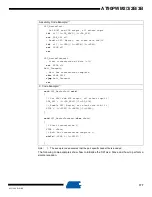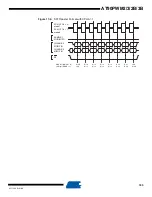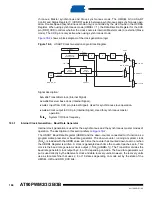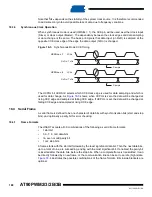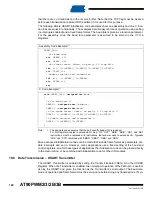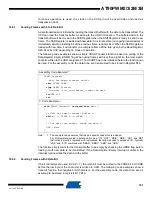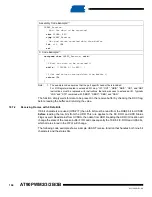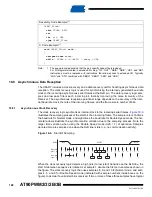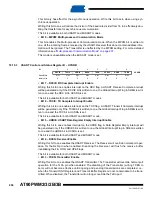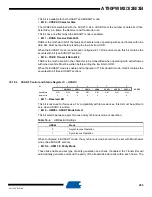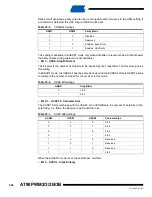
191
4317I–AVR–01/08
AT90PWM2/3/2B/3B
chronous operation is used, the clock on the XCK pin will be overridden and used as
transmission clock.
18.6.1
Sending Frames with 5 to 8 Data Bit
A data transmission is initiated by loading the transmit buffer with the data to be transmitted. The
CPU can load the transmit buffer by writing to the UDR I/O location. The buffered data in the
transmit buffer will be moved to the Shift Register when the Shift Register is ready to send a new
frame. The Shift Register is loaded with new data if it is in idle state (no ongoing transmission) or
immediately after the last stop bit of the previous frame is transmitted. When the Shift Register is
loaded with new data, it will transfer one complete frame at the rate given by the Baud Register,
U2X bit or by XCK depending on mode of operation.
The following code examples show a simple USART transmit function based on polling of the
Data Register Empty (UDRE) flag. When using frames with less than eight bits, the most signifi-
cant bits written to the UDR are ignored. The USART has to be initialized before the function can
be used. For the assembly code, the data to be sent is assumed to be stored in Register R16
.
Note:
1. The example code assumes that the part specific header file is included.
For I/O Registers located in extended I/O map, “IN”, “OUT”, “SBIS”, “SBIC”, “CBI”, and “SBI”
instructions must be replaced with instructions that allow access to extended I/O. Typically
“LDS” and “STS” combined with “SBRS”, “SBRC”, “SBR”, and “CBR”.
The function simply waits for the transmit buffer to be empty by checking the UDRE flag, before
loading it with new data to be transmitted. If the Data Register Empty interrupt is utilized, the
interrupt routine writes the data into the buffer.
18.6.2
Sending Frames with 9 Data Bit
If 9-bit characters are used (UCSZ = 7), the ninth bit must be written to the TXB8 bit in UCSRB
before the low byte of the character is written to UDR. The following code examples show a
transmit function that handles 9-bit characters. For the assembly code, the data to be sent is
assumed to be stored in registers R17:R16.
Assembly Code Example
(1)
USART_Transmit:
;
Wait for empty transmit buffer
sbis
UCSRA,UDRE
rjmp
USART_Transmit
;
Put data (r16) into buffer, sends the data
sts
UDR,r16
ret
C Code Example
(1)
void
USART_Transmit(
unsigned char
data )
{
/*
Wait for empty transmit buffer
*/
while
( !( UCSRA & (1<<UDRE)) )
;
/*
Put data into buffer, sends the data
*/
UDR = data;
}

